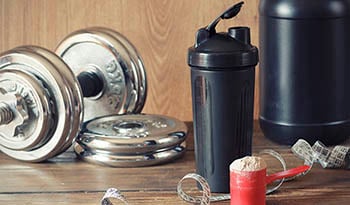Casein vs Whey Protein: When to Use Each to Support Performance
DISCLAIMER:This blog does not intend to provide diagnosis...
- In this article:
- What Are Whey and Casein Proteins?
- Whey Protein
- Casein Protein
- Which is Better? Whey vs. Casein Protein
- Digestion Rate
- Best Times to Consume Protein
- Best Ways to Consume Each
- Nutrition
- Final Thoughts

Two of the most popular supplements for active individuals and those living healthy lifestyles are casein and whey protein powders. In fact, if you regularly work out, then you’d be hard-pressed to find someone around you who doesn’t consume some form of a protein shake every once in a while, whether it’s with regularity or not.
Protein is essential for active individuals, as it plays a major role in the recovery and formation of new muscle. When we work out, we place stress on the muscle, which then creates a higher need for protein in order to properly rebound and come back stronger. Protein is also essential for body weight and body composition maintenance.
Whey and casein protein shakes are great supplements because they’re easy to add into any diet and they help boost daily protein intake—they’re essentially a fail-safe to ensure you’re consuming enough protein.
In this article, we’re going to discuss what whey and casein proteins are, the main differences between them, when to consume each, how to use each, and much more!
What Are Whey and Casein Proteins?
Before diving into whey vs casein differences, it’s a good idea to first understand what each protein is. Each type of protein will have their own variations, and understanding these subtle differences can help you make a better decision about which one to consume.
Whey Protein
Whey protein shakes are dairy-based products that are derived from the liquid by-products from cheese production. Whey protein shakes are digested rapidly by the body, which makes them great for supporting muscle protein synthesis in a timely manner.
There are multiple variants for the traditional whey protein shake. The different types of whey protein will impact digestibility and mixability. The three most common types of whey protein include:
- Whey concentrate: Somewhat processed and contains a small amount of fat and carbohydrates
- Whey protein isolate: Processed whey that has lactose and fat removed
- Whey protein hydrolysate: A highly processed whey that goes through a process which essentially makes it “predigested” (not literally, of course) to increase the bioavailability
It’s important to understand the differences between the types of whey protein because a higher quality whey—an isolate or hydrolysate—will generally result in better bioavailability, less digestional discomfort due to less lactose, and will mix better in every type of liquid.
Casein Protein
Casein protein, similar to whey, is a byproduct derived from cheese production. This protein lines the inside of the stomach when consumed and is digested much more slowly, which makes it great for sustained protein release.
Like whey protein, casein protein also has a couple of main variants that are worth knowing. Different casein proteins will differ based on how much each is processed, which is suggested to create a difference in digestion. The two main types of casein worth knowing include:
- Micellar casein: The most common, left in-tact type of casein powder on the market
- Hydrolyzed casein: Processed casein that is proposed to be slightly easier on digestion
A notable difference between whey and casein protein variants is that the different types of casein powder are still pretty under-researched. Since casein is a slow-digesting protein source, there’s an argument to be made that a hydrolyzed, more expensive processed casein is not worth the price since the research is still too sparse to suggest any definitive claims.
Which is Better? Whey vs. Casein Protein
At a topical level, whey and casein protein shakes are similar because they’re both dairy-based and contain ample protein per serving. Additionally, whey and casein protein powders are both complete protein sources, which means they contain all nine essential amino acids (the building blocks of protein).
Outside of these two main similarities, these products contain multiple differences that are worth knowing for anyone debating their consumption. By understanding their differences, we can make the best-educated decisions for when these products should be effectively used in one’s daily regimen.
After all, since these are supplements, their use should be supplemental to one’s diet in a way that both makes sense and supports performance.
Digestion Rate
The main and most notable difference between whey and casein protein powder is the rate in which each is digested. This difference is fundamental to understand because it can help dictate when to effectively consume each for growth and recovery.
Whey protein is digested by the body quickly, which makes it great for supporting muscle protein synthesis. This is why many suggest consuming a whey protein shake after a workout or upon waking up in the morning—two times when an influx in protein can be most readily used by the body.
When thinking about whey protein’s digestion rate and which variant is quickest, it’s easiest to think about the three types on a spectrum of speed. The more processed the whey protein is, the faster it will digest, as it will require the body to expend less energy breaking down and utilizing the protein.
Whey concentrate would be the slowest to digest, and Whey protein hydrolysate would be the fastest, leaving Whey protein isolate somewhere in between.
The differences between each type of protein above are relatively small, but the slight edge is often enough to make many consider the differences in digestion speed for rapid utilization of protein when picking a product.
Conversely to the rapid digestion of whey protein, casein is a much slower-protein. When casein is consumed, it forms a thick, gel-like substance in the stomach, which then prolongs its digestion and breakdown, creating a sustained protein release.
This changes casein’s best uses when compared to whey because a slower-digesting protein is obviously not ideal in settings where protein is needed by the body.
Best Times to Consume Protein
Since whey and casein vary so greatly in digestion rates, they’ll each differ in regard to when they should be consumed. In reality, both supplements can be consumed at any time of day, but again, we’re talking about the most effective ways to consume each.
Best Times to Consume Whey Protein:
- Before or after exercise
- As a midday snack to boost the snack’s protein content
- With breakfast, if protein-heavy foods are not available
Best Times to Consume Casein Protein:
- Before bed
- As a snack to stave off hunger and promote fullness
Generally, casein will be consumed predominantly before bed because the sustained release of protein can help promote recovery through the night as we sleep.
Best Ways to Consume Each
Whey and casein protein can both be mixed into water or milk and drank as shakes, however, with their vast differences in thickness this isn’t always a pleasant experience.
Whey protein will generally mix better with liquid, which will make it easier to consume and drink without it getting clumpy or too thick. In addition to being mixed in a shake form with your favorite liquid, whey protein can also be added to things like oatmeal to boost protein content in a normally carbohydrate-heavy food.
Casein protein will be a lot thicker when mixed in liquid, which can make it very unpleasant to drink—imagine drinking slightly watered down ice cream. This being said, casein is great to consume like a pudding. Instead of mixing casein in a shake, mix it in a bowl and add water or milk, then it can be consumed just like a pudding. Casein can also be mixed in foods like oatmeal and ice cream.
Nutrition
Generally, there won’t be a huge difference in the calorie and macronutrient content between whey and casein protein shakes. The slight differences will come down to the type of whey and casein being consumed. More processed products contain less fat and carbohydrates, which usually decrease total caloric content.
To provide an idea of what normal servings include, we’ve listed a typical calorie and macronutrient spectrum for whey and casein proteins.
Note: The below information will vary based on the product. These are general numbers that can be expected to be found in whey and casein protein powders.
Whey Protein Isolate:
- Calories: 120
- Fat: 0g
- Carbohydrates: <1g
- Protein: 30g
Casein Protein:
- Calories: 120
- Fat: 1g
- Carbohydrates: 3g
- Protein: 24g
As you can see, there’s not a huge difference between the calorie and macronutrients between the products, and that’s why it’s important to understand their differences in digestion rate and uses.
When selecting a whey or casein protein to supplement into your daily diet, make sure to account for each product’s calories and macronutrient breakdown to ensure it fits your daily needs. For example, a high-calorie option would not be ideal for those that are trying to lose weight with limited calories to play with.
Note: It’s always a good idea to consult the appropriate medical professional before implementing any new supplement into your diet. In the case of first-time consumers of these products, it’s also a good idea to consult a dietitian to help dictate best consumption practices.
Final Thoughts
Whey and casein protein powders share a lot in common with one another when it comes to their composition, but vary pretty greatly when it comes to their best application practices. By understanding the differences between the two, active individuals can create a game plan for each protein’s use that best coincides with their goals.
References:

 By Jake Boly, CSCS
By Jake Boly, CSCS


